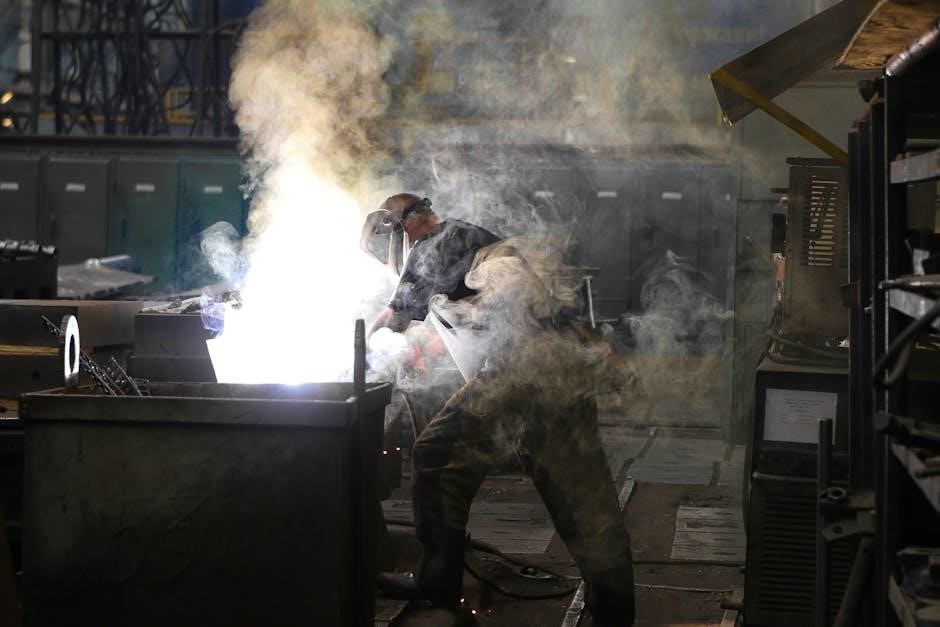Miller Welder Manual: A Comprehensive Guide
Miller welder manuals serve as indispensable resources. They offer detailed insights into operation, maintenance, safety, troubleshooting, and parts identification. Accessing these manuals ensures welders have the information necessary for optimal performance and longevity.
Understanding Miller Welders
Miller Electric stands as a world leader in welding equipment. They are known for manufacturing MIG, TIG, and Stick welders. They also produce wire feeders, welding guns, and engine-driven power sources. Miller is also known for producing automation controls and plasma cutters.
To truly understand Miller welders, one must appreciate their commitment to quality. Miller was the first welding equipment manufacturer in the U.S.A. to be registered to the ISO 9001 Quality System Standard. This dedication translates into reliable and durable machines. Miller‘s technology reduces training time and simplifies parameter setup.
Miller welders are designed with the operator in mind. They offer user-friendly interfaces. They also offer advanced features for precision welding. Whether you are a seasoned professional or a novice welder, Miller provides solutions to meet your needs. Their manuals provide detailed answers to product questions.
Miller welders are versatile. They are capable of handling various welding processes. These processes include SMAW, GMAW, and GTAW welding. Their equipment supports both manual and semiautomatic operations. By understanding the core principles and technology behind Miller welders, users can unlock their full potential.

Types of Miller Welder Manuals
Miller offers a range of manuals tailored to specific needs. The primary types include owner’s manuals, technical manuals, and service manuals. Each serves a distinct purpose, providing comprehensive guidance for Miller welding equipment.
Owner’s manuals are designed for end-users. They cover basic operation, safety precautions, and setup procedures. These manuals provide essential information for getting started with a Miller welder.
Technical manuals delve deeper into the inner workings of the machines. They offer detailed schematics, troubleshooting guides, and parts lists. They are intended for technicians and experienced users.
Service manuals provide in-depth repair procedures and diagnostic information. These manuals are essential for authorized service centers. They are also useful for individuals with advanced technical skills.
In addition to these core types, Miller also offers welding process manuals. They cover SMAW, GTAW, and GMAW techniques. These manuals provide guidance on best practices for different welding applications. Understanding the various types of Miller welder manuals ensures users can access the information. They can also access the expertise required to maintain and repair their equipment effectively. Each manual type is crafted to address specific user needs. Therefore, making the most of Miller‘s comprehensive documentation.
Accessing Miller Welder Manuals: Online Resources
Locating Miller welder manuals online is straightforward. Miller’s official website provides a comprehensive resource for accessing manuals. Users can search for specific models using serial numbers. This ensures they obtain the correct manual for their equipment.
The Miller website offers downloadable PDF versions of manuals, allowing users to view them on various devices. This digital accessibility enhances convenience and ensures that information is readily available.
ManualsLib is another valuable online resource. It hosts a vast collection of Miller Electric Welding System manuals. Users can browse by model or search for specific documents.
Additionally, online forums and welding communities often share links to Miller welder manuals. These platforms can be helpful for finding older or less common manuals. They also provide a space for users to exchange information.
When downloading manuals from unofficial sources, it’s crucial to verify their authenticity. This ensures the information is accurate and reliable. Always prioritize Miller’s official website or reputable sources like ManualsLib.
By utilizing these online resources, welders can quickly access the information. Accessing this information helps them to maintain, troubleshoot, and operate their Miller equipment safely and effectively.
Free Downloads vs. Paid Manuals
Miller welder manuals are often available as free downloads from Miller’s official website and resources like ManualsLib. These digital versions offer convenient access to essential information. This information includes safety precautions, operating procedures, and troubleshooting tips.
However, printed copies of Miller manuals are also available for purchase. These printed manuals can be beneficial for users who prefer a physical document. It is also beneficial for those who require a manual in environments where digital devices are impractical.
The cost of printed manuals typically includes shipping and handling fees. Contacting Miller directly or authorized distributors is necessary to order them. While free downloads provide immediate access to information, paid manuals offer a tangible resource.
Consider the advantages of each option when deciding which format to acquire. Free downloads are easily accessible and searchable. In contrast, paid manuals provide a durable, physical reference.
Ultimately, the choice between free downloads and paid manuals depends on individual preferences. It also depends on the specific needs and working conditions of the welder. Both options ensure access to the critical information. This information is needed to operate and maintain Miller welding equipment effectively.

Key Information Found in Miller Manuals: Safety Precautions
Miller welder manuals place significant emphasis on safety precautions. They aim to protect operators from potential hazards associated with welding; These manuals provide detailed guidelines to ensure a safe working environment.
The safety information covers various aspects, including personal protective equipment (PPE) requirements; This includes the necessity of wearing welding helmets, gloves, and protective clothing. These are to shield against arc radiation, sparks, and hot materials.
Manuals also outline proper ventilation practices to mitigate exposure to harmful fumes and gases. They stress the importance of working in well-ventilated areas. Local exhaust systems are needed to remove contaminants from the breathing zone.
Electrical safety is another critical focus. Manuals detail procedures for grounding equipment and avoiding electrical shock hazards. This includes inspecting cables for damage and ensuring proper insulation.
Fire prevention measures are thoroughly addressed, emphasizing the need to remove flammable materials from the welding area. This includes having fire extinguishers readily available.
Furthermore, manuals provide specific warnings about potential hazards associated with different welding processes and materials. Understanding and adhering to these safety precautions is paramount. It ensures welder safety and prevents accidents.
Miller manuals serve as essential resources for promoting a culture of safety in welding operations.
Key Information Found in Miller Manuals: Operation and Setup
Miller welder manuals provide comprehensive guidance on operation and setup. They are designed to help users, regardless of their experience level. Proper setup ensures optimal welding performance and longevity of the equipment.
These manuals offer step-by-step instructions for preparing the welder for use. This includes connecting power sources, gas supplies, and work clamps. They explain how to properly ground the equipment to prevent electrical hazards.
Detailed explanations of various welding parameters are provided. These parameters include voltage, amperage, wire feed speed, and gas flow rates. The manuals offer guidance on adjusting these settings for different materials and welding processes.
Manuals also cover the selection of appropriate welding consumables. This includes choosing the correct type and size of welding wire, electrodes, and shielding gases. They outline the importance of matching consumables to the base material.
Operating instructions are clearly explained. They provide users with a thorough understanding of how to initiate and control the welding process. This includes techniques for maintaining a consistent arc length and travel speed.
Furthermore, the manuals address specific operational considerations for different welding modes. These modes include Stick, MIG, TIG, and pulsed welding. They detail the unique settings and techniques required for each.
Miller manuals serve as invaluable resources. They empower welders to achieve consistent, high-quality welds. This also allows them to maximize the capabilities of their equipment.
Key Information Found in Miller Manuals: Maintenance and Troubleshooting
Miller welder manuals are invaluable resources for maintenance and troubleshooting. They provide detailed instructions. This ensures the longevity and optimal performance of your welding equipment.
Maintenance sections cover essential tasks. This includes regular cleaning, inspection of components, and lubrication. These manuals guide users through checking and replacing worn parts. They highlight the importance of maintaining proper ventilation.

Troubleshooting guides help diagnose and resolve common issues. They describe symptoms, possible causes, and step-by-step solutions. This helps users identify problems such as arc instability, wire feeding issues, and overheating.
Manuals also offer detailed diagnostic procedures. This includes using multimeters to test electrical circuits. They provide guidance on interpreting error codes. This aids in pinpointing specific malfunctions.
Safety precautions are emphasized throughout. They outline safe practices for performing maintenance and repairs. This includes disconnecting power, wearing protective gear, and handling hazardous materials properly.
Detailed diagrams and exploded views are included. These provide visual aids for understanding the internal components. This assists in disassembling and reassembling parts during maintenance.
Miller manuals serve as comprehensive guides. They empower users to effectively maintain and troubleshoot their welding equipment. This reduces downtime and extends the lifespan of their welders. Proper maintenance ensures consistent welding performance.
Finding Replacement Parts Using Manuals
Miller welder manuals are essential for locating replacement parts. They offer detailed parts lists with diagrams. This makes identifying and ordering the correct components straightforward.
Manuals include exploded views of the welder. This provides a visual representation of how parts fit together. Each part is labeled with a unique identification number. This simplifies the process of finding the exact replacement needed.
The parts lists typically provide descriptions, part numbers, and quantities required. This ensures users order the correct item. It helps to avoid compatibility issues. These lists often include information on superseded parts.
Miller manuals frequently list recommended suppliers. They also list authorized service centers. This helps users find reputable sources for genuine Miller parts. Using genuine parts ensures proper fit and performance.
Manuals also contain information on related accessories. This includes welding guns, cables, and consumables. It helps users maintain a complete and functional welding setup. Illustrations and diagrams aid in identifying these accessories.
By consulting the Miller welder manual, users can confidently identify. And they can order the correct replacement parts. This minimizes downtime. It also maximizes the lifespan of their welding equipment. Detailed parts information ensures proper repairs.
Using the manual can also save time and money. This helps to avoid ordering incorrect parts. This leads to efficient and cost-effective maintenance. Regular maintenance with the right parts ensures welder reliability.
Miller Welder Manuals for Specific Models
Miller welder manuals are tailored to specific models. Each manual contains precise information relevant to that particular welder. This includes detailed specifications, operation instructions, and troubleshooting guidance.
Model-specific manuals ensure users have accurate data. This is critical for safe and efficient operation. Miller produces manuals for a wide range of welders. This includes MIG, TIG, stick welders, and multi-process machines.
These manuals provide detailed diagrams and illustrations. These are specific to the model. This helps users understand the welder’s components and functions. Each manual covers unique features and settings of the model.
Miller welder manuals often include model-specific wiring diagrams. They also include circuit board layouts. This is essential for troubleshooting electrical issues. It also aids in performing advanced repairs.

The manuals provide recommended settings for different welding processes. They also include metal types. This helps users optimize performance. Model-specific manuals offer guidance. This ensures optimal weld quality and efficiency.
Miller offers manuals for both current and discontinued models. This allows users to maintain even older equipment. Accessing the correct manual for your Miller welder is crucial. It ensures proper operation and maintenance.
Using the model number, you can find the right manual. This helps to download it from Miller‘s website. This provides easy access to the information.